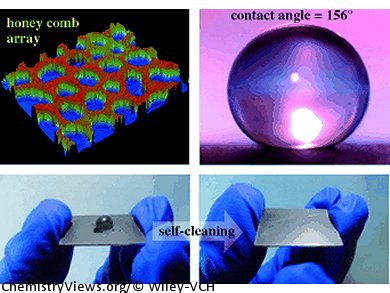Researchers in Germany and India have reported that a molecule containing a naphthalene diimide core with two guanidinocarbonyl pyrrole “arms” can form highly ordered self-assembled microarrays. The team, led by T. Govindaraju and Carsten Schmuck, Jawaharlal Nehru Centre for Advanced Scientific Research, India, and Universität Duisburg-Essen, Germany, respectively, showed that the “breath-figure technique”, which involves drop-casting a solution onto a surface under humid air, evaporation of the solvent, and subsequent condensation of water droplets onto the cold surface, can also be applied to small molecules.
The molecules can form self-assembled structures with solvent-dependent morphologies, including particulate, filmlike, microwell, and honeycomb-like. The morphologies were also found to be concentration-dependent, and the surface roughness and hence wettability could be tuned from hydrophilic to hydrophobic by changing the concentration of the deposited solutions.
The researchers increased the hydrophobicity of the surface by coating it with a thin layer of gold, and the wettability of the resulting surface could be further influenced by attaching thiol-containing compounds that bear different terminal groups. When a fluorinated compound was used, the surface showed self-cleaning properties, that is, the water droplets that are repelled can also clean up dust. This phenomenon is also seen in nature, for example, in the lotus leaf.
The team also experimented with incorporating fluorescent dyes into the structures, and anticipate constructing white-light-emitting hydrophobic materials.
- Self-Cleaning Functional Molecular Materials,
M. B. Avinash, Elisabeth Verheggen, Carsten Schmuck, T. Govindaraju,
Angew. Chem. Int. Ed. 2012, 51, 10324–10328.
DOI: 10.1002/anie.201204608 - M. B. Avinash, E. Verheggen, C. Schmuck, T. Govindaraju,
Angew. Chem. 2012, 124, 10470–10474.
DOI: 10.1002/ange.201204608




